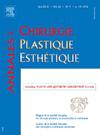整形外科对假性黄疽弹性体相关皮肤病变的治疗。
IF 0.4
4区 医学
Q4 SURGERY
引用次数: 0
摘要
背景:假黄疽弹性瘤(PXE)是一种遗传性结缔组织疾病,其特点是弹性纤维进行性钙化和碎裂,主要影响皮肤、视网膜和动脉壁。皮肤损伤表现为黄色丘疹,可合并形成皮肤皱褶。与此同时,颈部两侧和最大褶皱处的皮肤也会过度增生。皮肤的这些变化对美观、功能和心理都有很大影响,尤其是对女性而言:我们评估了本大学医院所有 PXE 患者的治疗方案。这组患者包括住院接受疾病评估的患者和申请手术矫正的患者。手术的目的不是完全切除病灶,而是缩小病灶和收紧皮肤:结果:2007 年至 2022 年间,共接诊了 250 名患者。29名女性和1名男性接受了手术治疗。主要的干预措施是采用标准技术,如颈面部拉皮术、肱骨整形术和腓肠肌整形术。术后随访结果显示,无论从美观还是功能上看,手术效果都令人满意,甚至非常好。没有术后并发症的记录:既没有瘀伤,也没有疤痕问题。PXE患者的愈合与正常人无异:结论:PXE 期间观察到的多余皮肤的手术治疗方法描述不多。然而,当这些多余的皮肤成为麻烦时,可以通过利用和调整传统的整形外科方法来收紧皮肤,从而将其去除。本文章由计算机程序翻译,如有差异,请以英文原文为准。
Treatment of skin lesions related to pseudoxanthoma elasticum in plastic surgery
Background
Pseudoxanthoma elasticum (PXE) is a hereditary disorder of connective tissue characterized by progressive calcification and fragmentation of elastic fibers, which primarily affects the skin, retinal and arterial walls. Skin damage takes the form of yellow papules that can merge to create a cutaneous fold. This is accompanied by an excess of skin on the different sides of the neck and in the largest folds. These changes to the skin have a significant aesthetic, functional and psychological impact, especially among women.
Patients and methods
We evaluated the treatment options in all patients with PXE of our University-Hospital. This group contains people who have been hospitalized for the assessment of their disease and applicants for surgical correction. The goal of the surgery was not the total removal of the lesions but instead a decrease in their size and a tightening of the skin.
Results
In total, 250 patients were seen between 2007 and 2022. Surgical treatment was advised for 29 women and 1 man. The main interventions were based on standard techniques such as cervico-facial facelifts, brachioplasties and cruroplasties. The results obtained during postoperative follow-up consultations were rated satisfactory to very good, both aesthetically and functionally. There were no postoperative complications recorded: neither bruising nor scarring issues. Patients with PXE heal as normal.
Conclusion
Surgical treatment for excess skin observed during PXE is poorly described. Yet, these excesses can be removed when they become troublesome by making use of and adapting the traditional methods of plastic surgery for tightening of the skin.
Contexte
Le pseudoxanthome élastique (PXE) est une maladie héréditaire du tissu conjonctif caractérisée par une calcification et une fragmentation progressives des fibres élastiques, qui affecte principalement la peau, la rétine et les parois artérielles. Les lésions cutanées prennent la forme de papules jaunes qui peuvent fusionner pour créer un pli cutané. Cela s’accompagne d’un excès de peau sur les différentes faces du cou et dans les plis les plus importants. Ces modifications de la peau ont un impact esthétique, fonctionnel et psychologique significatif, surtout chez les femmes.
Patients et méthodes
Nous avons évalué les options thérapeutiques chez tous les patients atteints de PXE de notre hôpital universitaire. Ce groupe comprend des personnes ayant été hospitalisées en vue d’une évaluation de leur maladie ainsi que des candidats à une correction chirurgicale. L’objectif de l’intervention chirurgicale n’était pas l’élimination totale des lésions, mais plutôt une diminution de leur taille et une remise en tension de la peau.
Résultats
Au total, 250 patients ont été examinés entre 2007 et 2022. Le traitement chirurgical a été conseillé à 29 femmes et 1 homme. Les principales interventions étaient basées sur des techniques standard telles que les liftings cervico-faciaux, les brachioplasties et les cruroplasties. Les résultats obtenus lors des consultations de suivi postopératoire ont été jugés satisfaisants à très bons, tant sur le plan esthétique que fonctionnel. Aucune complication postopératoire n’a été consignée : ni hématomes, ni problèmes de cicatrisation. La cicatrisation des patients atteints de PXE se déroule normalement.
Conclusion
Le traitement chirurgical de l’excès de peau observé au cours du PXE est peu décrit. Pourtant, cet excès peut être éliminé lorsqu’il devient gênant en utilisant et en adaptant les méthodes traditionnelles de la chirurgie plastique pour la remise en tension de la peau.
求助全文
通过发布文献求助,成功后即可免费获取论文全文。
去求助
来源期刊
CiteScore
1.00
自引率
0.00%
发文量
86
审稿时长
44 days
期刊介绍:
Qu''elle soit réparatrice après un traumatisme, pratiquée à la suite d''une malformation ou motivée par la gêne psychologique dans la vie du patient, la chirurgie plastique et esthétique touche toutes les parties du corps humain et concerne une large communauté de chirurgiens spécialisés.
Organe de la Société française de chirurgie plastique reconstructrice et esthétique, la revue publie 6 fois par an des éditoriaux, des mémoires originaux, des notes techniques, des faits cliniques, des actualités chirurgicales, des revues générales, des notes brèves, des lettres à la rédaction.
Sont également présentés des analyses d''articles et d''ouvrages, des comptes rendus de colloques, des informations professionnelles et un agenda des manifestations de la spécialité.

 求助内容:
求助内容: 应助结果提醒方式:
应助结果提醒方式:


